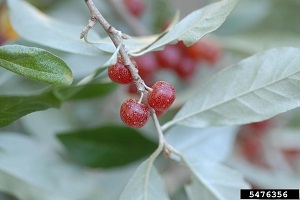|
Aug. 13, 2020
Contact: Joanne Foreman, 517-284-5814
For landscapes plagued by autumn olive or entangled in oriental bittersweet, a new website offers help identifying and managing woody invasive plants like these.

WoodyInvasives.org, developed by the Woody Invasives of the Great Lakes Collaborative, contains a wealth of information about how to distinguish woody invasive species from similar beneficial plants, an interactive map showing how these species are regulated by Great Lakes jurisdictions, detailed management approaches and noninvasive woody plant ideas for gardeners and landscape designers.
“We developed the WIGL Collaborative website to help people learn to identify the woody invasive plants around them and to feel empowered to start controlling them on their properties or in their favorite green places,” said Clair Ryan, coordinator of the Midwest Invasive Plant Network, the organization leading the effort.
|
Across the eight Great Lakes states and Ontario, 28 woody plant species are regulated as invasive by at least one jurisdiction. Invasive species are those that are not native and can cause harm to the environment, economy or human health.
Woody plants, including trees, shrubs and vines, have strong stems with a bark layer. These stems persist through winter and releaf in the spring. Multiflora rose, black locust, Tatarian honeysuckle and glossy buckthorn are just some of the woody invasive species found in Michigan.

Invasive plants often share characteristics that make them difficult to manage, including early germination in open areas or disturbed soils, fast growth rates, rapid spreading and the ability to sprout new plants from cut stems or roots.
Many plants now considered invasive were imported to the U.S. for landscaping, erosion control or property barriers, long before the threat of invasiveness was understood. Now these plants pose a serious threat to natural areas in the Great Lakes region, outcompeting native plants and damaging wildlife habitat.
Species profiles on WoodyInvasvies.org provide information on how each plant became established in the U.S., where they are likely to be found and what problems they cause to native habitats.
|
Profiles also include:
- Identification information and photos.
- Native look-alikes.
- How and where species are regulated.
- Recommended landscape alternatives.
The site also offers detailed information on control methods, along with explanations of where and when each method is most effective. Useful tips on long-term management and how to properly dispose of plant debris are also included.
The Woody Invasives of the Great Lakes Collaborative is one of several regional invasive species initiatives supported by the Great Lakes Restoration Initiative.
Michigan's Invasive Species Program is cooperatively implemented by the Department of Environment, Great Lakes, and Energy, the Department of Natural Resources and the Department of Agriculture & Rural Development.
/Note to editors: The accompanying photos are available for download. Caption information follows.
Autumn olive: Autumn olive is an invasive shrub identifiable by its leaves, which are bright green on top and silver underneath. Red berries with white speckles are visible in the fall. Photo courtesy of Kathy Smith, Ohio State University Extension, Bugwood.org.
Black locust: Black locust is a fast-growing tree with compound leaves and brown to black seed pods visible in the fall. Photo courtesy of Leslie J. Mehrhoff, University of Connecticut, Bugwood.org.
Glossy buckthorn: Glossy buckthorn, often found in wetlands or along roadsides, has shiny, simple leaves and pea-sized fruit that ripens from green to red to dark purple. Photo courtesy of Leslie J. Mehrhoff, University of Connecticut, Bugwood.org.
Multiflora rose: Multiflora rose is a multi-stemmed shrub that produces white to pink flowers in spring and bright red rose hips in fall. Photo courtesy of Rob Routledge, Sault College, Bugwood.org./
|